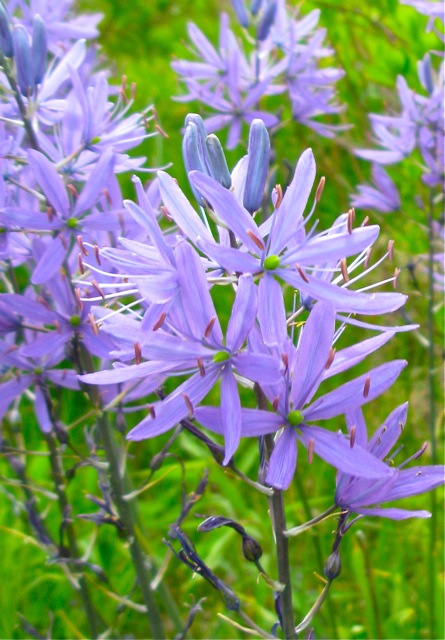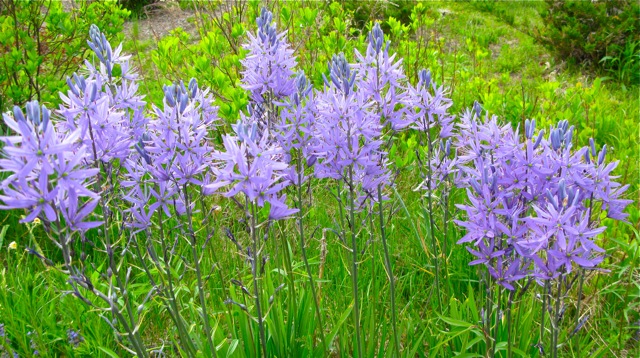A Tall, Cool Drink for the Eyes: Quiet, Calm Camassia – Wild American Beauty of the Marshland and Meadow…
 Camassia quamash, North American native Camas Lily, © 2010 Michaela at TGE
Camassia quamash, North American native Camas Lily, © 2010 Michaela at TGE
A few years ago, at the low edge of my garden where open meadow meets slow transition to cultivated borders, I planted a handful of native camas lily bulbs, (Camassia quamash). The first spring after planting, an orphaned fawn wandered into my life, and he nibbled the tops off my camas lilies before they could bloom. Did you just gasp? I probably would have too, if I’d never met “L’il Deer”. My reaction may surprise you. I’m not denying that I winced -loudly- when I caught my voracious guest browsing my garden – but I quickly fell head over heels in love with that fawn, and his presence in my life was more than worth the sacrifice of a few blue blossoms. Funny how that works… Â isn’t it? Â Â (I promise to tell you more about my friend the fawn another day.)
Beloved by bees, butterflies and hummingbirds, camas lilies have a long and interesting history as a food source for many creatures – including humans. Before the arrival of Europeans to the North American continent, sweet camas bulbs were harvested and eaten raw by Native Americans. Although I have never tried them (it’s hard to pull them up when they produce such beautiful flowers) the flavor is described as chestnut-like, with a creamy, pleasant cooked texture…
 Camassi quamash © 2010, Michaela at TGE
Camassi quamash © 2010, Michaela at TGE
Camas lily species are all useful garden plants. Some, such as Camassia cusickii and leichtlinii, are stunning in perennial borders, and others, such as C. scilloides, (wild hyacinth), and C. quamsah, (common camas lily), are perfect for naturalizing at the edge of a pond, meadow or forest. Camas lilies are difficult to propagate from seed -and also challenging from divisions- but they are easily grown and readily available from most bulb companies for planting in fall. C. cusickii, (Cusick’s camas), as well as C.leichtlinii, (Leichtlin’s camas), and variously colored cultivars, from white to lavender and deep violet, form beautiful, well-mannered clumps in the garden.
Native to North America, from Canada to the southern plains, camas lilies range in hardiness from 3-9, depending upon the species. These beautiful and graceful flowers prefer locations with ample moisture in springtime, and later, as they go dormant in summer, they like for their soil to remain a bit drier. Position Camassia species and cultivars where they can be enjoyed blooming in late spring-early summer, and where other plants can fill in for them as their foliage dies back in dormancy. Once established, blue camas will create a soothing visual oasis in the garden, moving like water in a gentle stream with the slightest breeze. While they are blooming, I will forever picture a delicate fawn, drinking at a forest brook…
 Camassia at the Edge of the Meadow © 2010, Michaela at TGE
Camassia at the Edge of the Meadow © 2010, Michaela at TGE
***
Article and photographs © 2010 Michaela at The Gardener’s Eden
All content on this site, (with noted exceptions), is the property of The Gardener’s Eden and may not be used or reproduced without prior written consent. Inspired by something you see here? Great! Please give credit where credit is due. It’s a small world and link-love makes for fond friendships. Stealing makes for bad dreams…
Do you enjoy visiting The Gardener’s Eden? You can help support this site by shopping through our affiliate links. A small percentage of any sale originating from The Gardener’s Eden site will go toward web hosting and maintenance costs. Thank you for your support!
***
4 Replies to “A Tall, Cool Drink for the Eyes: Quiet, Calm Camassia – Wild American Beauty of the Marshland and Meadow…”
Comments are closed.


Love them. I tried Camassia cusickii for the first time this year, and they were a great addition. They have it all: structure, nice blooms, strappy foliage, and the bulbs really are delicious looking (I sliced into some by accident, having forgotten where I planted them earlier this spring). No deer came with mine though, just pretty flowers.
I saw them for the first time this year. I’ve always heard about the Native Americans using them as a food source in this area. I was so surprised at how tiny they are. It would take a lot of them to fill a tummy. They are so pretty in their delicate nature.
I’m so glad my clump of the camassia is spreading. They are wonderful this year. But I wonder which variety I planted. They look like your photograph. But, really, does it matter? Thanks for the discussion.